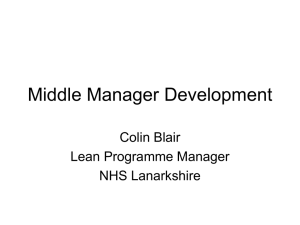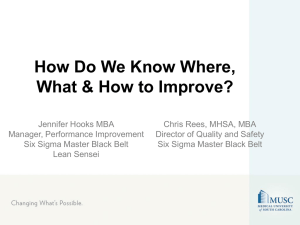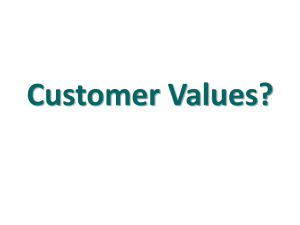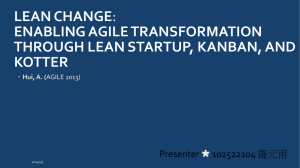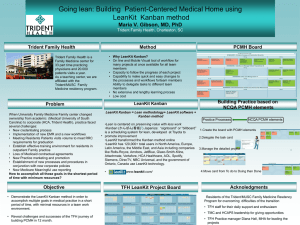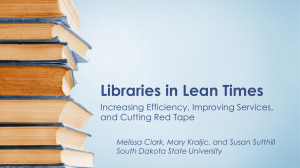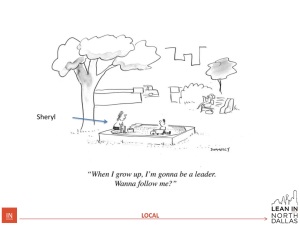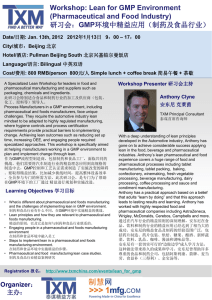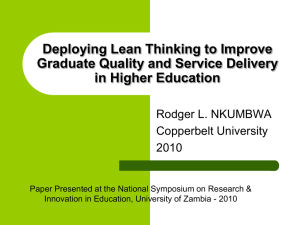Introduction to Continuous Improvement in Healthcare
advertisement
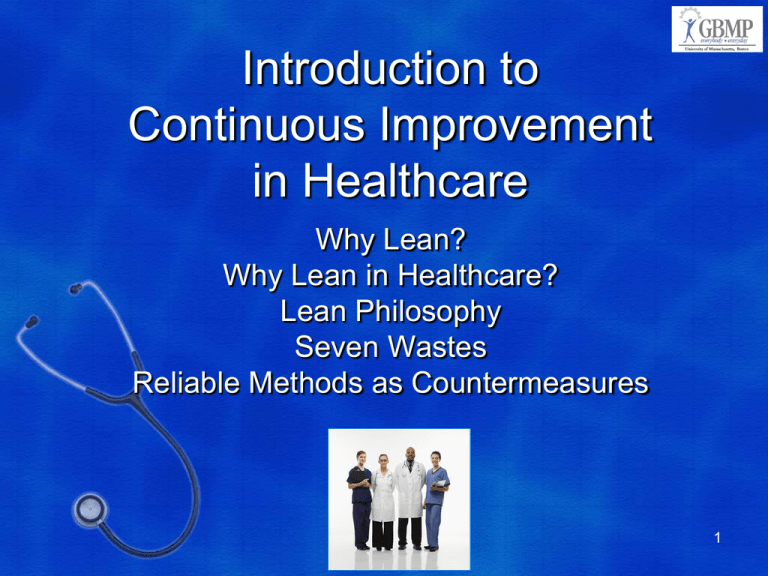
Introduction to Continuous Improvement in Healthcare Why Lean? Why Lean in Healthcare? Lean Philosophy Seven Wastes Reliable Methods as Countermeasures 1 Our Mission Is Simple: to help companies become more productive and competitive through Continuous Improvement education and implementation. • Hands-on consulting/training in Continuous Improvement • Award winning Training Products • Lean practitioners with a passion for Gemba-based learning • Promoting a culture of improvement • Not-for-Profit Organization www.gbmp.org 617-287-7737 “I would recommend participation to all healthcare department heads and quality improvement practitioners. GBMP did a great job applying the material to healthcare, "going to the gemba" after learning lean concepts and tools in order to apply knowledge learned in the classroom.” - Christine McMullan, Director of Continuous Quality Improvement, Stony Brook University Hospital Shingo Prize Shingo Prize Home of the Old Lean Dude, lean blogger - a lifetime of lean stories to share - Sign up at www.oldleandude.org © Greater Boston Manufacturing Partnership Introductions • Pat Wardwell, GBMP • Chief Operating Officer • 25+ years Operations and Improvement Roles • Lean Gold Certified • Shingo Prize Recipient • Shingo Prize Examiner • AME Excellence Award Council and Assessor 3 Why Lean in Healthcare? “While technologies and treatments have made enormous strides during my career, nuts-and-bolts hospital operations haven't.” – Dr. Patricia Gabow. Errors Work-Arounds Cost Reporting Requirements Payment Systems Waste Staff Frustration Silos Waiting 4 4 Desire to Improve Quality, Cost, Delivery and Safety of Care Lean in Healthcare Affinity Healthcare – A Healthcare Remedy 5 What Is “Traditional”? 6 What Is “Traditional Operating Methods”? Customer requirements not known Batch processing Pacing to “maximize” resources Processes/Equipment keep running despite defects Lack of standardization Questionable quality Operator’s work out of control Operators not working together Limited communication between operators and management. Management occasionally present 7 What Is “Traditional Healthcare”? Patient requirements poorly communicated Batch processing Unnecessary procedures and tests Lack of standardization Long wait times expected Questionable quality Staff working out of control Dr., nurse, and staff not working together Limited communication between staff and management Management occasionally present 8 What is Continuous Improvement? • An approach to healthcare which strives to maximize value to the patient by maximizing the value of employees. JIT Autonomation Standardization Stability 9 What is Continuous Improvement? Connects employees and patients. 10 Concept of Value and Waste • Value Added – Activities involved with the direct care of the patient – Activities the customer (Patient or Payer) is willing to pay for • Waste (Non-Value Added) – Activities that do not benefit the patient – Activities that fall under the 7 forms of waste – Activities not performed right the first time • Necessary Non-Value Added (Incidental Work) – Activities causing no value to be created but which cannot be eliminated based on current technology or regulations 11 What is Continuous Improvement? What is CI in Healthcare? • The primary focus of lean or CI is in developing people as problem solvers and participants in process improvement. • CI or lean is the creation of value for the customer through the relentless and iterative elimination of waste (muda), variation (mura) and strain (muri). • Value is defined as any action or process for which the customer would be willing to pay. • In Healthcare, value is defined as any action or process that directly contributes to the care of the patient. “Care that is patient-focused, with less waste and cost and better medical outcomes” - John Toussaint, On the Mend 12 Lean – The Big Picture 10% Techniques & 90% People Before strategy there is Philosophy. Techniques are the means, not the ends Management must lead. At the center is Human Development. Human Development Philosophy 13 Lean Philosophy Patient is First . . . • Patients expect zero errors • At an affordable price • With no waiting. Old Thinking Errors Expected Price = Cost + Profit Maximize for Physician New Thinking Zero Defects Profit = Price - Cost No Patient Waiting 14 Lean Philosophy Employees are the most valuable resource. • People want to make valuable contributions to the world. • Dissatisfaction is a normal and necessary condition for improvement. • 95% of objection is cautionary. • If employees truly understand value, they will gladly provide it. • People have limitless capability. 15 Lean Philosophy Direct Observation • Direct observation on regular basis is critical to understanding. • Best information for continuous improvement comes from direct observation and involvement with the people who do the work. • Workplace is dynamic. • Go to Gemba often! 16 Lean Philosophy Kaizen (continuous improvement) is for everybody, everyday. • Kaizen is small changes for the better that come from the common sense and experience of the people who do the work. • The more employees learn and use CI the better they become at problem-solving (tacit learning.) • Continuous improvement never ends. 17 Toast Kaizen 18 Toast Kaizen Event Metrics Measure Current Lead Time 4.2 min. 2.2 min. Floor Space 24 sq. ft. 4 sq. ft. Target Steps 25 4 Customer Happy? No Yes Job Easier? No Yes 19 Lean Summary • Everybody, everyday! • Patient focused. • 10% techniques & 90% people. • Is taken in small steps. • Produces orders of magnitude benefits. • Is not consistent with traditional approach. 20 Benefits of Lean • • • • • • • • • Highest Quality Lowest Cost Connects Patient to Staff Shortest Time Safer for Patient Least Strain for Caregiver Greatest Productivity Better use of Space Greatest Margin Flexibility There are no limits to improvement! 21 Process - Operation Model Operation P r o c e s s Feedback Reading Screening Admissions Main Reception Patient A Patient B Patient C 22 Process - Operation Model Admissions Main Reception Screening Reading Feedback Waste 95% of process is waste. 23 Seven Wastes 1. Inventory 2. Transportation 3. Waiting To get in 4. Motion To get out In patient rooms In stockrooms Between departments In hallways Patients and providers Information Supplies For results For medication, for food Searching, walking, backtracking, reaching, bending, climbing, taking eyes off of work 24 Seven Wastes 5. Processing 6. Defects 7. Over-production Worst Waste Patient being asked the same questions, unsafe or strain producing, Unnecessary, irrational Infections, wrong site surgeries, medication errors Excessive tests, unnecessary treatment 25 Reliable Methods • • • • • • • • • • Identify reliable methods. 5S - Workplace Organization Problem Solving for CI Teams Value Stream Mapping Create a Continuous Flow favorable Standardized Work environment. Kanban/ Pull Systems Visual Control Systems Set up Reduction Keep all Poka-yoke/ Error Proofing employees Heijunka/ Level Scheduling practiced. 26 5S - The First Improvement S1 – Sort Out S2 – Set Locations S3 – Shine S4 – Standardize S5 – Sustain 27 5S Video Essay 28 CEDAC Team Based Problem Solving Technique 29 Value Stream Mapping Good Process Good Result 30 Continuous Flow (Cells) • Reorganizing physically and organizationally for improved flow. • All steps used to complete a prcess are placed in sequence of production. No space between steps. • No material build-up between operations. • One piece flow. Spaghetti Diagram Lab Flow 31 Standardized Work • Best (current) combination of people, machines and material to complete process for patient demand. • Takt Time – time allowed by customer to complete the process • Cycle time - time to perform the process, including machine and manual time • Work Sequence - order of operations to complete the process • Stock on Hand – inventory required to maintain flow • Key safety and inspection points 32 Kanban • Kanban eliminates overproduction. • Kanban re-integrates inventory data with material. • Number of kanban cards controls level of inventory. • Delays (unavailable kanban) are highlighted immediately. • Kanban is like money, always try for less money in system. 33 Visual Control Systems Letting the Process Speak Visual Indicator Visual Signal Visual Control Visual Guarantee 34 Reducing Interruptions and Improving Patient Safety • A study involving nine San Francisco Bay Area hospitals focused on improving accuracy in administering drugs - with particular emphasis on reducing interruptions that often lead to mistakes - resulted in a nearly 88 percent drop in errors over 36 months at those hospitals. 35 Set-up Reduction • Reduce every set-up by “59/60th’s” • Separation of external from internal tasks • external = process running internal = process stopped • Convert internal to external tasks • Minimize adjustments • Improve overall set up • Focus on waste, not operation Equipment Patient Room Operating Room 36 Poka-yoke • Poka-yoke means to avoid (yokeru) inadvertent errors (poka). • “Preventing the act of forgetting what you have forgotten” -- Shigeo Shingo. • Respect the intelligence of staff by taking the judgment out of repetitive tasks where errors are likely to occur. Defects = 0 Cannot connect to the wrong tank! 71 Continuous Improvement Summary • Develop from Need • 90% People (Patients and Employees) • Focus on Workplace • Create Kaizen Way • Incremental use of reliable methods to counter 7 wastes Pull Systems Standardized Work Continuous Flow 5S and VSM 38 Key Points • Three aspects to TPS • Technical – tools like 5S, Kanban, Set Up Reduction • Philosophy (see below) • Management – new strategy, policy and organization • TPS (Lean) Philosophy: • Patient First • Employees most important resource • Direct observation. (Go see!) • Kaizen – small changes for the better, everybody, everyday • 7 Wastes • • • • • • • Storage Transportation Overproduction Processing Motion Defects Waiting • Basic hierarchy of improvement • • • • JIT Autonomation Standardization Stability Create a favorable environment: 90% people,10% methods! 39 Thank you! Questions 40
